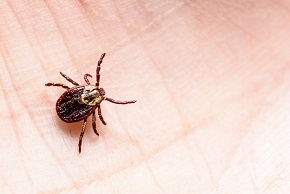What Is Lyme Disease?

Summertime is peak Lyme Disease season, and even though this malady is much more common in the northeastern United States than it is in the south, we Texans definitely aren’t immune to the disease. Here’s our quick guide to a surprisingly common, frequently underestimated tick borne illness:
Lyme Disease and Ticks
Lyme Disease is an infection caused by the Borrelia burgdorferi bacterium. Borrelia burgdorferi typically lives in the salivary glands of black-legged ticks (AKA deer ticks), so when an infected tick latches onto a human and pierces the person’s skin in order to feed, the disease can get into the human victim’s bloodstream and cause acute sickness.
What are the symptoms of Lyme Disease?
Those affected by Lyme Disease usually begin to exhibit signs of illness within three to thirty days of being bitten by an infected tick. Early indicators include:
- Flu-like symptoms, including fatigue, headache, chills, fever, swollen lymph nodes, and muscle and joint pain.
- Erythema migrans, which is a skin rash that has a distinctive “bullseye” shape: a spot of red (right at the bite site) surrounded by a circle of clear skin and then another circle of red. These rashes often feel warm to the touch but aren’t painful or itchy.
After 30 days, additional symptoms to look out for include:
- Facial paralysis that only affects one side of the face (AKA Bell’s Palsy).
- Additional rashes on the skin.
- Severe pain and swelling in the joints. Victims may also experience sudden “shooting” pains, which can make it difficult to fall or stay asleep.
- Heart palpitations.
- Brain and spinal cord inflammation.
- Nerve pain.
- Tingling sensations in the hands and feet.
- Short-term memory issues.
The good news is that, once diagnosed by a doctor, the disease can usually be cured with antibiotics and rest. When caught in its early stages, most patients make a full recovery within two to four weeks. However, if treatment is delayed, a patient may still grapple with symptoms like fatigue or muscle/joint pain months (or even years) after their condition has been cured.
How can I avoid contracting Lyme Disease?
The easiest way to avoid having to deal with Lyme is to avoid being bitten by a black-legged tick in the first place. Unfortunately, because ticks are small and can latch onto their human hosts without drawing attention to themselves, avoiding them can be a little easier said than done. Here are some tips for protecting yourself:
Be aware of your surroundings. Ticks usually live in grassy, wooded, or brushy environments. They also thrive in places where there are large amounts of dead leaves piled up. Thus, it can be extremely easy to pick up an “unwanted passenger” when hiking or biking through rural areas.
If you’re going to be out in nature, stick to established trails; don’t go bushwhacking through the wilderness. And if you receive word that ticks carrying Lyme Disease have been confirmed in certain places, try to avoid those spots entirely.
Cover your skin. Long pants, long sleeves, hats, ankle socks, and closed-toed shoes can all provide an effective barrier between yourself and any ticks you might encounter in your travels.
Check yourself. Give your skin a thorough inspection after spending time in a tick-friendly area. You might need to use a mirror to see those hard-to-reach places. Common spots where ticks like to settle on human bodies include the groin, the armpits, the belly button, the backs of the knees, and the scalp.
I found a tick on my (or my child’s) body! What should I do?
First of all, remain calm! Not every person who is bitten—and fed on—by a tick will contract Lyme. Tick encounters can be unsettling, but panicking won’t help the situation either. Instead, you should remain calm while taking immediate action.
- Remove the tick. Don’t waste time trying to smother the insect with petroleum jelly, liquid soap, or nail polish. Instead, simply remove it with a pair of fine-tipped tweezers. You’ll want to grab hold of the tick as close to the skin as possible and use firm, even pressure as you lift upward. Try to avoid twisting or “picking” motions, as this may cause the tick’s body to break away from its head.
- Dispose of the tick. Safe methods for killing ticks include drowning it in alcohol, flushing it down the toilet, or throwing it in the trash after sealing it in a plastic bag.
- Clean up. Apply iodine scrub, rubbing alcohol, or antibacterial soap and water to the bite site.
- Stay wary. If, in the next few days, the bite victim reports (or exhibits) any of the early symptoms of Lyme, they should see a doctor right away. Be ready to explain when the bite occurred, where on the victim’s body the tick was found, and your best guess as to where the tick came from.
Lyme Disease can be scary to think about, but the good news is that it’s fairly preventable and mostly curable. If your physician diagnoses another illness, such as the flu, and you believe to be experiencing symptoms of Lyme, ensure a urine mycotoxin test is scheduled to determine if mycotoxins are present in the body. If the urine mycotoxin test comes back positive, it is prudent to purchase a mold environmental test from a reputable lab to verify your home is the culprit. If you have any reason to believe that there’s a mold infestation in your house, take action immediately.
Have a Question?
Send us your comments and questions and our team of mold experts will answer your questions!
"*" indicates required fields
